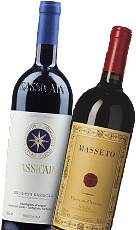
Gaja
The history of this dynasty was founded in 1859 when the great-great grandfather John founded the historical Gaja winery in Barbaresco since then this has been synonymous with quality. It was Angelo, the second generation of the family, to focus on quality production already in the early '900.
He was the first to understand that the export was the trump card for Italian wine: his products were started being offered on the U.S. market. Today he has a hundred hectares of vineyards in Piedmont, and more than two hundred in Tuscany, adding that the production Piedmont with the most famous Tuscan wines, Brunello di Montalcino in the head.
Oenologist Guido Rivella is the soul of all the wines from the Gaja family. When, in the mid-sixties, he joined the tour of great food, has an excellent array of wines. Then come the cru: the first, San Lorenzo in 1967. In 1970 Sorì Tildin and in 1978 it was the turn of Costa Russi. Today the brand means 92 hectares property carried out in full respect of nature, for a production of about 350,000 bottles a year.

Gaja Wine Awards
Precious bottles, which perfectly reflect the personality of Angelo, or rather his way of understanding the wine. He was the first to dare to innovate this wine with techniques that go after killing dizzying production per hectare (for better quality), to control fermentation temperature, the use of caps and long aging in oak barrels. There are many magazines that have talked about him as a true legend of the wine world, considering that his Barbaresco 1985 was defined by Wine Spectator "the best wine ever produced in Italy ", in 1998 the British Decanter elected him" Man of the Year "and, finally, in 2011 still American Wine Spectator honored even by their cover.
He was also awarded as Prize for Lifetime Achievement, the prestigious German magazine of reference dedicated to the business of international wine Meininger's Wine Business International, for a successful life as a man who made history, innovated, looked over and wagered bringing its wines and its name in the Olympus of world enology.


















